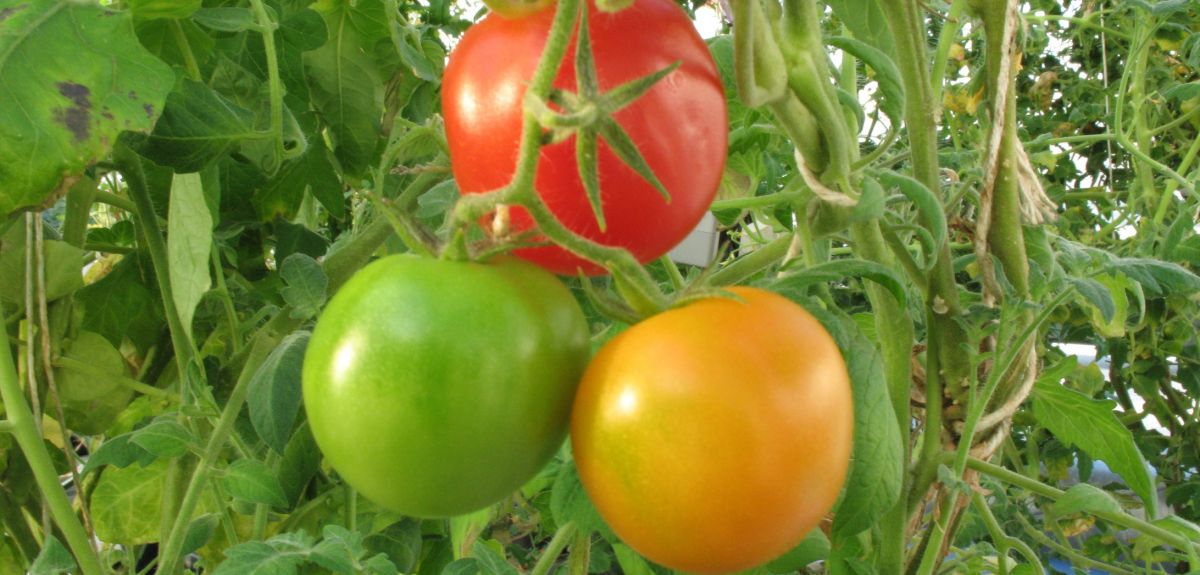
Credit: Paul Jarvis
Oxford scientists discover how to alter colour and ripening rates of tomatoes
Scientists at the University of Oxford’s Department of Plant Sciences have discovered how the overall process of fruit ripening in tomato (including colour changes and softening) can be changed –speeded up or slowed down – by modifying the expression of a single protein located in subcellular organelles called the plastids. This offers a novel opportunity for crop improvement.
The production of fruit is a vital process for plants because it enables them to reproduce and thrive. One strategy that plants use to ensure that their fruit are successful is to give them a colourful appearance, so that they are attractive to animals for seed dispersal.
In tomato, the fruit ripening process involves dramatic changes in tiny “organelles” inside the fruit cells called plastids. It is these plastids that are responsible for giving colour to the fruit.
In spite of their central importance in delivering fruit colour, surprisingly little was known about how plastids participate in the ripening process.
The regulatory properties of SP1 revealed in our study show that it has real potential as a technology for crop improvement
The Oxford team has now discovered a function in fruit for a protein located in the plastids called SP1 (this SP1 protein controls a regulatory pathway called CHLORAD, which was discovered by the group in 2019). The new finding reveals an important regulatory or controlling role for plastids in the fruit ripening process in tomato.
Significantly, the results published today in Nature Plants provide a theoretical basis for the modification or manipulation of the ripening of fleshy fruits such as tomato, providing a novel opportunity for crop improvement.
Corresponding author, Professor Paul Jarvis from Oxford’s Department of Plant Sciences, said: ‘The regulatory properties of SP1 revealed in our study show that it has real potential as a technology for crop improvement. For example, it could be used to develop early or late fruiting varieties of fleshy fruits, or to improve the transportability or shelf-life of fruit by delaying ripening without compromising the quality of the ripe fruit.
‘It’s fascinating that the amount of a single protein in these tiny subcellular structures called plastids can have such far-reaching consequences for fruit ripening in tomato.’
The work is based on the modification of the expression of the tomato SP1 gene (as well as the related tomato SPL2 gene) in transgenic tomato plants. Transgenic plants with reduced or elevated levels of expression of SP1 were studied in detail, using a range of techniques including phenotyping, electron microscopy, gene expression analysis, and metabolomics.
The work was funded by the Biotechnology and Biological Sciences Research Council (BBSRC).
Watch this related video:
Read the full paper, 'The chloroplast-associated protein degradation pathway controls chromoplast development and fruit ripening in tomato' in Nature Plants.
 Expert Comment: Why has Trump launched so many tariffs and will it cause a recession?
Expert Comment: Why has Trump launched so many tariffs and will it cause a recession?
 Expert Comment: Is it possible to support both AI innovation and human creativity?
Expert Comment: Is it possible to support both AI innovation and human creativity?
 Oxford unmasks the fraudsters behind the forgeries for April Fakes Day 2025
Oxford unmasks the fraudsters behind the forgeries for April Fakes Day 2025